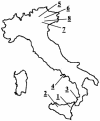Benign familial infantile convulsions: mapping of a novel locus on chromosome 2q24 and evidence for genetic heterogeneity
- PMID: 11326335
- PMCID: PMC1226140
- DOI: 10.1086/320596
Benign familial infantile convulsions: mapping of a novel locus on chromosome 2q24 and evidence for genetic heterogeneity
Abstract
In 1997, a locus for benign familial infantile convulsions (BFIC) was mapped to chromosome 19q. Further data suggested that this locus is not involved in all families with BFIC. In the present report, we studied eight Italian families and mapped a novel BFIC locus within a 0.7-cM interval of chromosome 2q24, between markers D2S399 and D2S2330. A maximum multipoint HLOD score of 6.29 was obtained under the hypothesis of genetic heterogeneity. Furthermore, the clustering of chromosome 2q24-linked families in southern Italy may indicate a recent founder effect. In our series, 40% of the families are linked to neither chromosome 19q or 2q loci, suggesting that at least three loci are involved in BFIC. This finding is consistent with other autosomal dominant idiopathic epilepsies in which different genes were found to be implicated.
Figures


References
Electronic-Database Information
-
- Généthon, http://www.genethon.fr
References
-
- Charlier C, Singh NA, Ryan SG, Lewis TB, Reus BE, Leach RJ, Leppert M (1998) A pore mutation in a novel KQT-like potassium channel gene in an idiopathic epilepsy family. Nat Genet 18:53–55 - PubMed
-
- Chen Y, Yu L (1994) Differential regulation by cAMP-dependent protein kinase and protein kinase C of the μ-opioid receptor coupling to a G protein-activated K+ channel. J Biol Chem 269:7839–7842 - PubMed
-
- De Fusco M, Becchetti A, Patrignani A, Annesi G, Gambardella A, Quattrone A, Ballabio A, Wanke E, Casari G (2000) The nicotinic receptor β2 subunit is mutant in nocturnal frontal lobe epilepsy. Nat Genet 26:275–276 - PubMed
-
- Dib C, Faure S, Fizames C, Samson D, Drouot N, Vignal A, Millasseau P, Marc S, Hazan J, Seboun E, Lathrop M, Gyapay G, Morissette J, Weissenbach J (1996) A comprehensive genetic map of the human genome on 5.264 microsatellites. Nature 380:152–154 - PubMed
Publication types
MeSH terms
Substances
Associated data
- Actions
- Actions
- Actions
- Actions
- Actions
- Actions
- Actions
- Actions
Grants and funding
LinkOut - more resources
Full Text Sources

